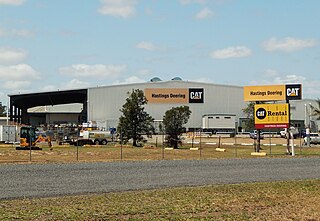
Yeppoon is a coastal town and locality in the Shire of Livingstone, Queensland, Australia. Yeppoon is renowned for its beaches, tropical climate, and the islands out on the bay. Located 41 kilometres (25 mi) from the city of Rockhampton, Yeppoon is the seat of the Shire of Livingstone and the principal town on the Capricorn Coast, a string of seaside communities stretching more than 150 kilometres (93 mi) from north to south. The beaches and shallow coves provide a destination both for tourists and retirees settling down in Central Queensland. Offshore, there are 27 islands including Great Keppel Island which is 20 kilometres (12 mi) from Yeppoon. In the 2021 census, the locality of Yeppoon had a population of 7,037 people; this does not include any neighbouring suburbs.

Emerald is a rural town and locality in the Central Highlands Region, Queensland, Australia. The town is the headquarters for the Central Highlands Regional Council.

Mount Morgan is a rural town and locality in the Rockhampton Region, Queensland, Australia. The town was the administrative centre of the Mount Morgan Shire until March 2008, when it was amalgamated with neighbouring local government areas to form the Rockhampton Region.

Westwood is a town in the Rockhampton Region and a locality split between the Rockhampton Region and the Shire of Banana in Queensland, Australia. It was the first town that was gazetted by the Queensland Government. In the 2021 census, the locality of Westwood had a population of 199 people.

Rockhampton City is the central suburb of the city of Rockhampton in the Rockhampton Region, Queensland, Australia. It is informally known as Rockhampton central business district (CBD). In the 2021 census, Rockhampton City had a population of 2,059 people.

Wandal is a suburb of Rockhampton in the Rockhampton Region, Queensland, Australia. In the 2021 census, Wandal had a population of 3,949 people.

Wowan is a rural town and locality in the Shire of Banana, Queensland, Australia. In the 2021 census, the locality of Wowan had a population of 170 people.

Allenstown is an inner southern suburb of Rockhampton, Rockhampton Region, Queensland, Australia. It is situated 1.6 kilometres (0.99 mi) by road south-west of the Rockhampton CBD. In the 2021 census, Allenstown had a population of 2,762 people.

Berserker is a suburb of Rockhampton in the Rockhampton Region, Queensland, Australia. It is situated about six kilometres north east of the central business district.

Depot Hill is a suburb of Rockhampton in the Rockhampton Region, Queensland, Australia. In the 2021 census, Depot Hill had a population of 995 people.

Kawana is a suburb of Rockhampton in the Rockhampton Region, Queensland, Australia. In the 2021 census, Kawana had a population of 4,434 people.
The Common is a parkland suburb of Rockhampton in the Rockhampton Region, Queensland, Australia. In the 2021 census, The Common had "no people or a very low population".

Marmor is a rural town and locality in the Rockhampton Region, Queensland, Australia. In the 2021 census, the locality of Marmor had a population of 208 people.

Koongal is a suburb of Rockhampton in the Rockhampton Region, Queensland, Australia. In the 2021 census, Koongal had a population of 4,252 people.

Nerimbera is a rural locality in the Livingstone Shire, Queensland, Australia. In the 2021 census, Nerimbera had a population of 285 people.

Park Avenue is a suburb of Rockhampton in the Rockhampton Region, Queensland, Australia. In the 2021 census, Park Avenue had a population of 5,292 people.

The Caves is a rural town and locality in the Livingstone Shire, Queensland, Australia. In the 2021 census, the locality of The Caves had a population of 680 people.

Norman Gardens is a suburb in the Rockhampton Region, Queensland, Australia. In the 2021 census, Norman Gardens had a population of 10,534 people.

Port Curtis is a suburb of Rockhampton in the Rockhampton Region, Queensland, Australia. In the 2021 census, Port Curtis had a population of 309 people.
Lakes Creek is a suburb split between Rockhampton Region and Shire of Livingstone, Queensland, Australia. In the 2021 census, Lakes Creek had a population of 633 people.






















